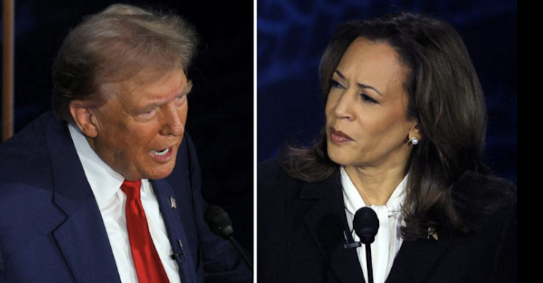Kamala Harris entered Tuesday night’s presidential debate with a clear strategy: to dominate and destabilize Donald Trump.
The debate began with her assertive move, as she crossed the stage in Philadelphia to demand a handshake. This was a clear attempt to seize control from an opponent known for his commanding presence on stage.
Since the debate, political analysts and networks have focused on Harris’s aggressive approach. Her jabs and personal attacks, coupled with her mocking laughter, seemed to unsettle Trump, who responded with visible anger.
The extensive media coverage of Harris’s performance reflects its effectiveness, with initial polls suggesting a decisive win for her. However, history shows that a debate win does not always translate into a general election victory in November. Harris’s bold approach was striking, but it was more about style than substance.
Before the debate, polls indicated that voters were eager to understand Harris’s stance on key issues. Her campaign has been criticized for being vague on detailed policy proposals. Trump’s policies are more established, and voters likely want clarity on his plans if re-elected.
In the debate, Harris did present some familiar policy proposals: a $6,000 child tax credit for infants, a $50,000 tax cut for small businesses, and $25,000 to assist first-time homebuyers with deposits. She also argued that Trump’s tariffs would lead to higher consumer prices. However, she did not address why the Biden administration, where she has served for nearly four years, has retained some of Trump’s tariffs.
Nor did Harris address how she would tackle inflation, a top concern for many voters.
Trump’s attempt to exploit this weakness by labeling Harris’s economic policies as “Marxist” faltered as he shifted to discussing illegal immigration, claiming that “bad immigration” is the worst economic threat. This exchange typified the debate’s tenor: high on heat but low on substantive policy discussion.
The Trump campaign has tried to paint Harris as a radical leftist, citing her previous support for banning fracking, nationalizing health insurance, and decriminalizing illegal border crossings. When asked about her changing positions, Harris promised to discuss each point but only addressed her vote for new fracking leases aimed at reducing reliance on foreign oil. Trump, flustered, missed the chance to critique her policy shifts effectively.
Instead of capitalizing on these opportunities, Trump focused repeatedly on immigration, his signature issue. Despite his firm stance on the topic, he failed to detail how he would manage the deportation of millions of illegal migrants, offering only familiar rhetoric without concrete plans.
The debate offered voters their first direct comparison of the two candidates. While it provided insights into their demeanor, temperament, and body language, it fell short on offering detailed plans for governance. A particularly telling moment came when Trump, despite his nine-year pledge to repeal the Affordable Care Act (Obamacare), admitted he still does not have a replacement plan, stating only, “I have the concepts of a plan.”
And after the 90-minute primetime showdown, voters were likely only left with “the concepts” of what either of these candidates would do if elected to the White House.




